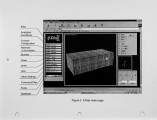| OCR Text |
Show 2.3. Basic Concepts In order to attain the aforementioned objectives, if-Diss has two basic concepts: • A model database integrating established mathematical models and technical know-how. • A user-friendly pre-processor specialized for industrial furnaces to reduce workload and time for pre-processing. if-Diss provides non-expert users user-friendly GUI (Graphical User Interface) and model database to conduct C F D analysis with well known commercialized C F D solvers. The time and workload for pre-processing are significantly reduced, resulting in less elapsed time for the entire process. Thus, extensive and effective use of C F D promises to be a powerful engineering tool for the design of industrial furnaces. 3. FEATURES OF if-Diss A unique feature of if-Diss is to systemize the whole pre-processing, such as specifying furnace configuration, choosing models, generating numerical grid and so on. It consists of model database, interface program and GUI. Users of if-Diss conduct pre-processing by inputting data interactively through GUI. Then, input data are forwarded to the interface program. The interface program translates them to the input files for C F D solvers. if-Diss generates necessary input files for major C F D solvers such as CFX, F L U E N T / U N S and STAR-CD. Another feature of if-Diss is network applicability. Coded with Java language, it runs on the network browser such as Netscape Navigator. Once if-Diss is installed to the network server, all network user shares the database. All user can update database by adding a new data as well. 3.1. Model database The database of if-Diss consists of three key parts depending on the type of stored data. The first part is a mathematical model database, which stores a number of mathematical models as user subprograms. For example, if-Diss provides various flame models, such as heat release distribution model, hot gas jet model, flat flame model and radiant tube burner model. Those models are stored as user subprograms. The second part stores data for series of input condition. For example, the database includes necessary burner data. If the user specified the burner name, then stored input condition such as burner size, velocity at burner tile, flame length and so on, appears on the display. The last part is physical property database. It stores thermal properties of materials, gases and fuels, which can be promptly used for CFD. The use of this database is shown in 3.3.4. 3.2. Mathematical models Phenomena occurring in industrial furnaces are so complicated that with the most advanced computers it is by no means possible to numerically simulate all of the phenomena. Proper simplification is necessary in practice, depending on the requirements for prediction. Knowledge on mathematical models together with their applicability and accuracy are very important to conduct practical C F D analysis. if-Diss basically provides a simple combination of models as a default setting, which is determined by experiences. The default setting is mainly for the users who do not have mathematical background. If an expert user need high 3 |



















